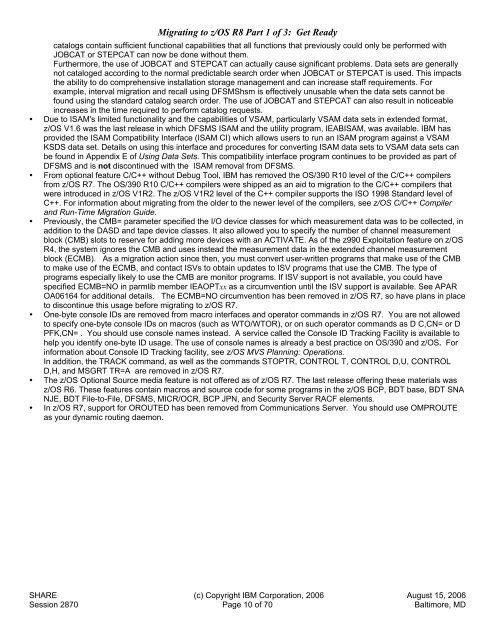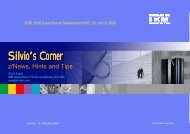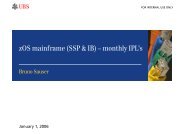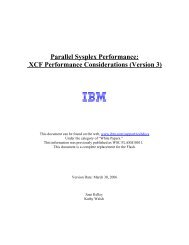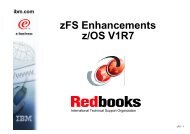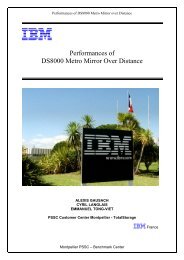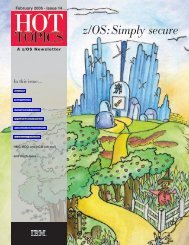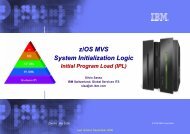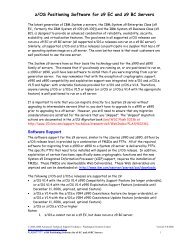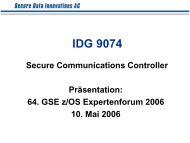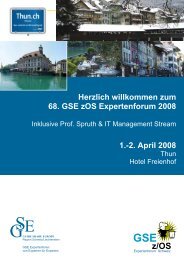Migrating to zOS R8 Part 1 - Messmer The Brain House
Migrating to zOS R8 Part 1 - Messmer The Brain House
Migrating to zOS R8 Part 1 - Messmer The Brain House
You also want an ePaper? Increase the reach of your titles
YUMPU automatically turns print PDFs into web optimized ePapers that Google loves.
<strong>Migrating</strong> <strong>to</strong> z/OS <strong>R8</strong> <strong>Part</strong> 1 of 3: Get Ready<br />
catalogs contain sufficient functional capabilities that all functions that previously could only be performed with<br />
JOBCAT or STEPCAT can now be done without them.<br />
Furthermore, the use of JOBCAT and STEPCAT can actually cause significant problems. Data sets are generally<br />
not cataloged according <strong>to</strong> the normal predictable search order when JOBCAT or STEPCAT is used. This impacts<br />
the ability <strong>to</strong> do comprehensive installation s<strong>to</strong>rage management and can increase staff requirements. For<br />
example, interval migration and recall using DFSMShsm is effectively unusable when the data sets cannot be<br />
found using the standard catalog search order. <strong>The</strong> use of JOBCAT and STEPCAT can also result in noticeable<br />
increases in the time required <strong>to</strong> perform catalog requests.<br />
� Due <strong>to</strong> ISAM's limited functionality and the capabilities of VSAM, particularly VSAM data sets in extended format,<br />
z/OS V1.6 was the last release in which DFSMS ISAM and the utility program, IEABISAM, was available. IBM has<br />
provided the ISAM Compatibility Interface (ISAM CI) which allows users <strong>to</strong> run an ISAM program against a VSAM<br />
KSDS data set. Details on using this interface and procedures for converting ISAM data sets <strong>to</strong> VSAM data sets can<br />
be found in Appendix E of Using Data Sets. This compatibility interface program continues <strong>to</strong> be provided as part of<br />
DFSMS and is not discontinued with the ISAM removal from DFSMS.<br />
� From optional feature C/C++ without Debug Tool, IBM has removed the OS/390 R10 level of the C/C++ compilers<br />
from z/OS R7. <strong>The</strong> OS/390 R10 C/C++ compilers were shipped as an aid <strong>to</strong> migration <strong>to</strong> the C/C++ compilers that<br />
were introduced in z/OS V1R2. <strong>The</strong> z/OS V1R2 level of the C++ compiler supports the ISO 1998 Standard level of<br />
C++. For information about migrating from the older <strong>to</strong> the newer level of the compilers, see z/OS C/C++ Compiler<br />
and Run-Time Migration Guide.<br />
� Previously, the CMB= parameter specified the I/O device classes for which measurement data was <strong>to</strong> be collected, in<br />
addition <strong>to</strong> the DASD and tape device classes. It also allowed you <strong>to</strong> specify the number of channel measurement<br />
block (CMB) slots <strong>to</strong> reserve for adding more devices with an ACTIVATE. As of the z990 Exploitation feature on z/OS<br />
R4, the system ignores the CMB and uses instead the measurement data in the extended channel measurement<br />
block (ECMB). As a migration action since then, you must convert user-written programs that make use of the CMB<br />
<strong>to</strong> make use of the ECMB, and contact ISVs <strong>to</strong> obtain updates <strong>to</strong> ISV programs that use the CMB. <strong>The</strong> type of<br />
programs especially likely <strong>to</strong> use the CMB are moni<strong>to</strong>r programs. If ISV support is not available, you could have<br />
specified ECMB=NO in parmlib member IEAOPTxx as a circumvention until the ISV support is available. See APAR<br />
OA06164 for additional details. <strong>The</strong> ECMB=NO circumvention has been removed in z/OS R7, so have plans in place<br />
<strong>to</strong> discontinue this usage before migrating <strong>to</strong> z/OS R7.<br />
� One-byte console IDs are removed from macro interfaces and opera<strong>to</strong>r commands in z/OS R7. You are not allowed<br />
<strong>to</strong> specify one-byte console IDs on macros (such as WTO/WTOR), or on such opera<strong>to</strong>r commands as D C,CN= or D<br />
PFK,CN= . You should use console names instead. A service called the Console ID Tracking Facility is available <strong>to</strong><br />
help you identify one-byte ID usage. <strong>The</strong> use of console names is already a best practice on OS/390 and z/OS. For<br />
information about Console ID Tracking facility, see z/OS MVS Planning: Operations.<br />
In addition, the TRACK command, as well as the commands STOPTR, CONTROL T, CONTROL D,U, CONTROL<br />
D,H, and MSGRT TR=A are removed in z/OS R7.<br />
� <strong>The</strong> z/OS Optional Source media feature is not offered as of z/OS R7. <strong>The</strong> last release offering these materials was<br />
z/OS R6. <strong>The</strong>se features contain macros and source code for some programs in the z/OS BCP, BDT base, BDT SNA<br />
NJE, BDT File-<strong>to</strong>-File, DFSMS, MICR/OCR, BCP JPN, and Security Server RACF elements.<br />
� In z/OS R7, support for OROUTED has been removed from Communications Server. You should use OMPROUTE<br />
as your dynamic routing daemon.<br />
SHARE (c) Copyright IBM Corporation, 2006 August 15, 2006<br />
Session 2870 Page 10 of 70 Baltimore, MD


